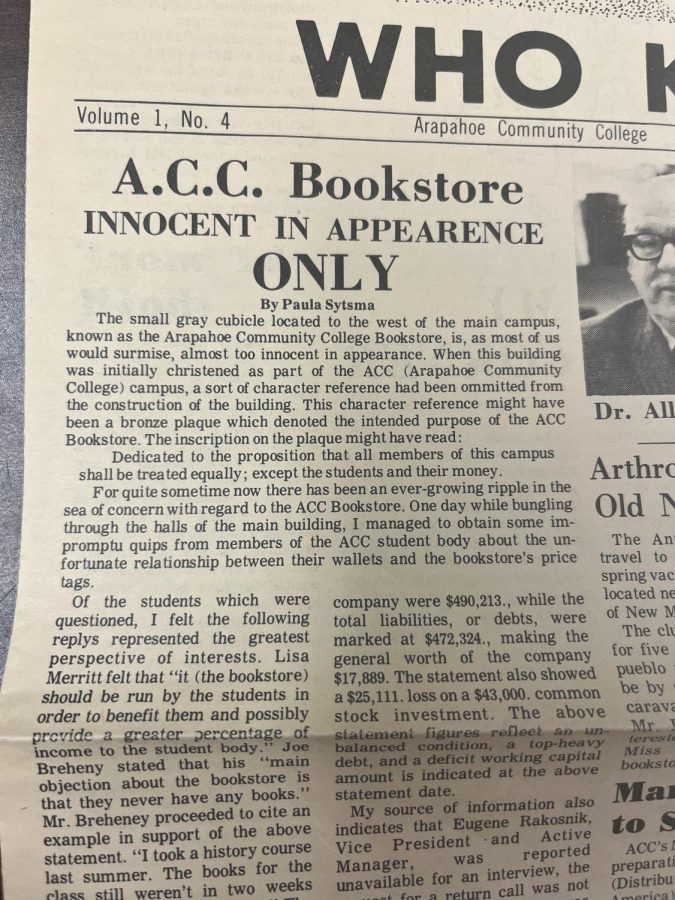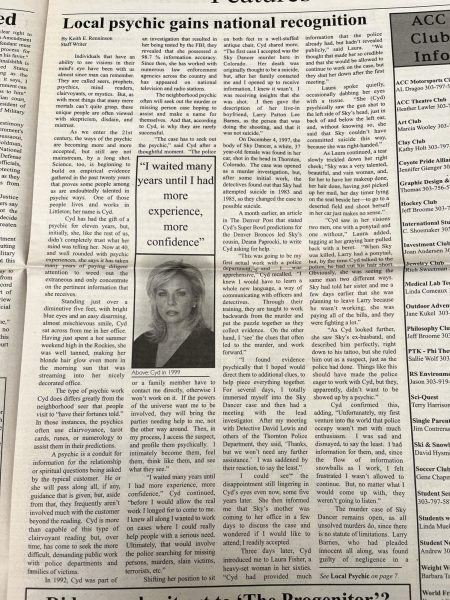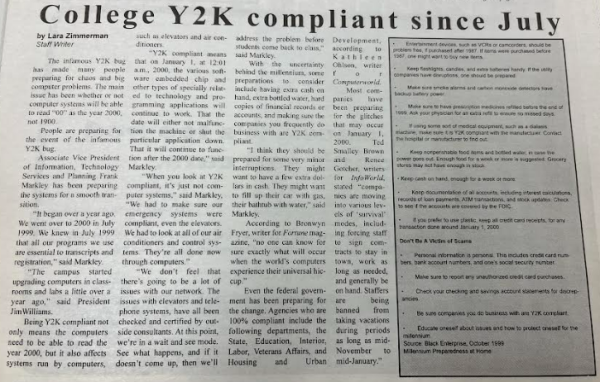Throwback Thursday: A.C.C. Bookstore Innocent in Appearance ONLY
Note: This piece was originally published in the 1971, Volume 1, Issue 4 Who Knows, Arapahoe Community College’s Student Newspaper at the time.
The small gray cubicle located to the west of the main campus, known as the Arapahoe Community College Bookstore, is, as most of us would surmise, almost too innocent in appearance. When this building was initially christened as part of the ACC (Arapahoe Community College) campus, a sort of character reference had been ommitted from construction of the building. This character reference might have been a bronze plaque which denoted the intended purpose of the ACC Bookstore. The inscription on the plaque might have read:
Dedicated to the proposition that all members of this campus shall be treated equally; except the students and their money.
For quite some time now there has been an ever-growing ripple in the sea of concern with regard to the ACC Bookstore. One day while bungling through the halls of the main building, I managed to obtain some impromptu quips from members of the ACC student body about the unfortunate relationship between their wallets and the bookstore’s price tags.
Of the students which were questioned, I felt the following replys rerpresented the greatest perspective of interests. Lisa Merritt felt that “it (the bookstore) should be run by the students in order to benefit them and possibly provide a greater percentage of income to the student body.” Joe Breheny stated that his “main objection about the bookstore is they never have any books.” Mr. Breheny proceeded to cite an example in support of the above statement. I took a history course last summer. The books for the class still weren’t in two weeks after the start of the quarter.” The summer quarter is only eight weeks long. On a more defensive note, Mrs. Joy Krelling feels that “they’ve been very understanding in accepting returns when I purchased goods or supplies which were unnecessary to the course curriculum.”
When interviewed, Mrs. Alice Stambaugh, manager of the ACC bookstore, was able to submit only a very small amount of information. The bookstore apparently tries to take advantage of quantity purchases in order to pursue the “cash discount.” They reportedly mark up their books 20 per cent of the wholesale price, while with trade books (paperbacks) the markup is 40 per cent. The bookstore originally obtained their contract with ACC through bidding procedures. A supposed 5 per cent of the bookstore’s gross profit is relinquished to the administration, who in turn incorporates this sum into the student activities fund.
The following information is the product of a confidential business report of a leading, nation-wide credit authority. The ACC Bookstore is a branch of Bargain Bookstore, Incorporated, located at 406 15th Street in Denver. However, there has been a reported change of address to 520 West Colfax Avenue. The Denver office is affiliated with the Nebraska corporation charatered on September 13, 1962, with authorized capital consisting of 1,000 shares of common stock at $100 par value. According to a statement of July 31, 1969, filed with the office of the Secretary of the State of Colorado on January 13, 1970, the total assets of the company were $490,213., while the total liabilities, or debts, were marked at $472,324., making the general worth of the company $17,889. The statement also showed a $25,111. loss on a $43,000. common stock investment. The above statement figures reflect an unbalanced condition, a top-heavy debt, and a deficit working capital amount is indicated at the above statement date.
My source of information also indicates that Eugene Rakosnik, Vice President and Active Manager, was reported unavailable for an interview, the request for a return call was not answered, and the bookkeeper was not authorized to release financial information.
Sales of the organizations new books represent 65 per cent of the volume, which leaves a residue of 35 per cent on book mark ups. This does conflict with Mrs. STambaugh’s figure of 20 per cent.
The condition continues to be regarded as unbalanced with debt well in excess of stockholder’s equity.
This is the organization behind our college bookstore. What can be done to ease the discomfort of high purchasing prices and low cash returns on the same book? Of receiving books two weeks late when a course is but eight weeks long? Alternatives have been suggested, discussed, and have even been born in motion. However, a lack of enthusiasm seems to be a precedent over school concern. If not for the sake of anything else, at least have concern for your own dollar.













